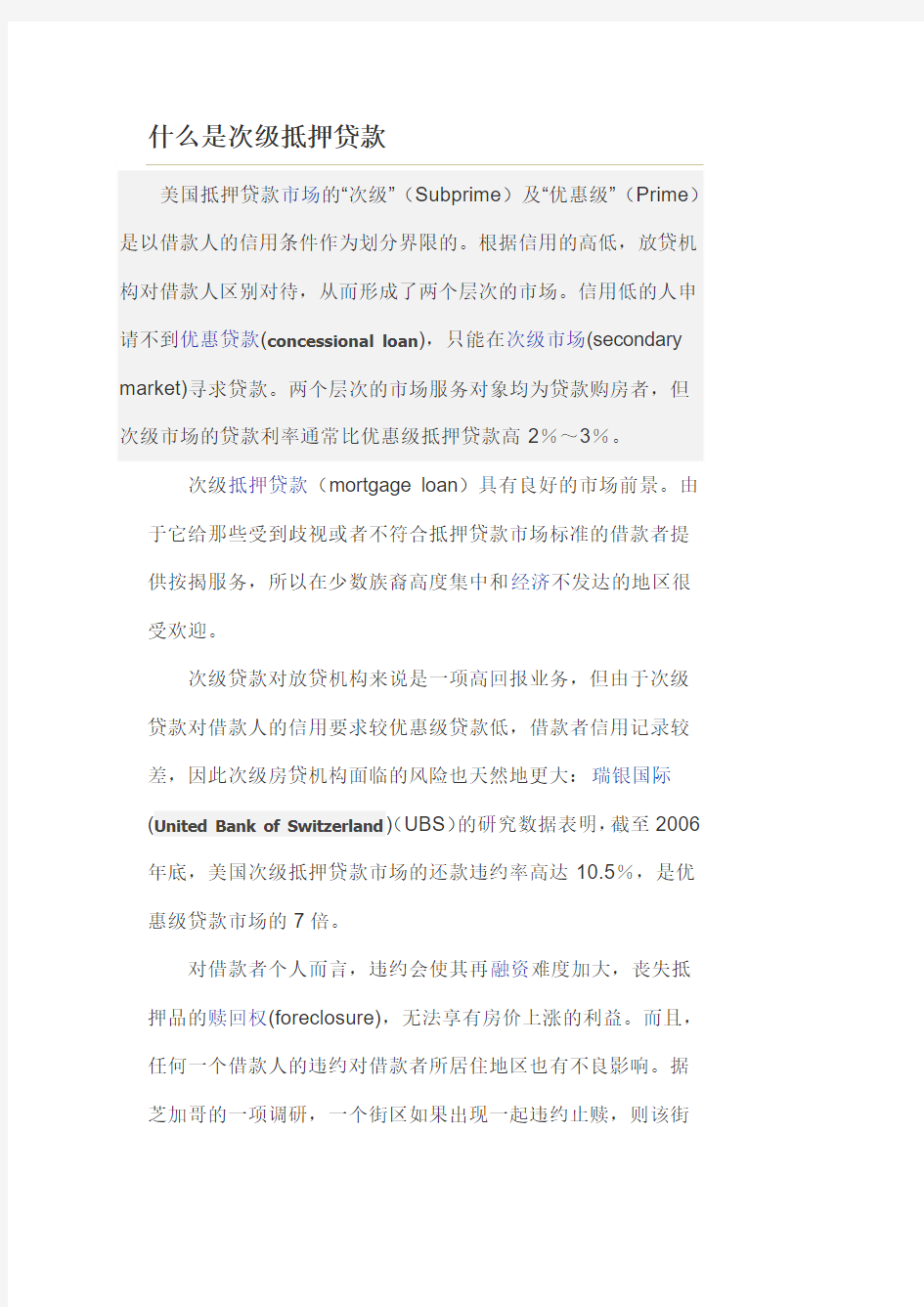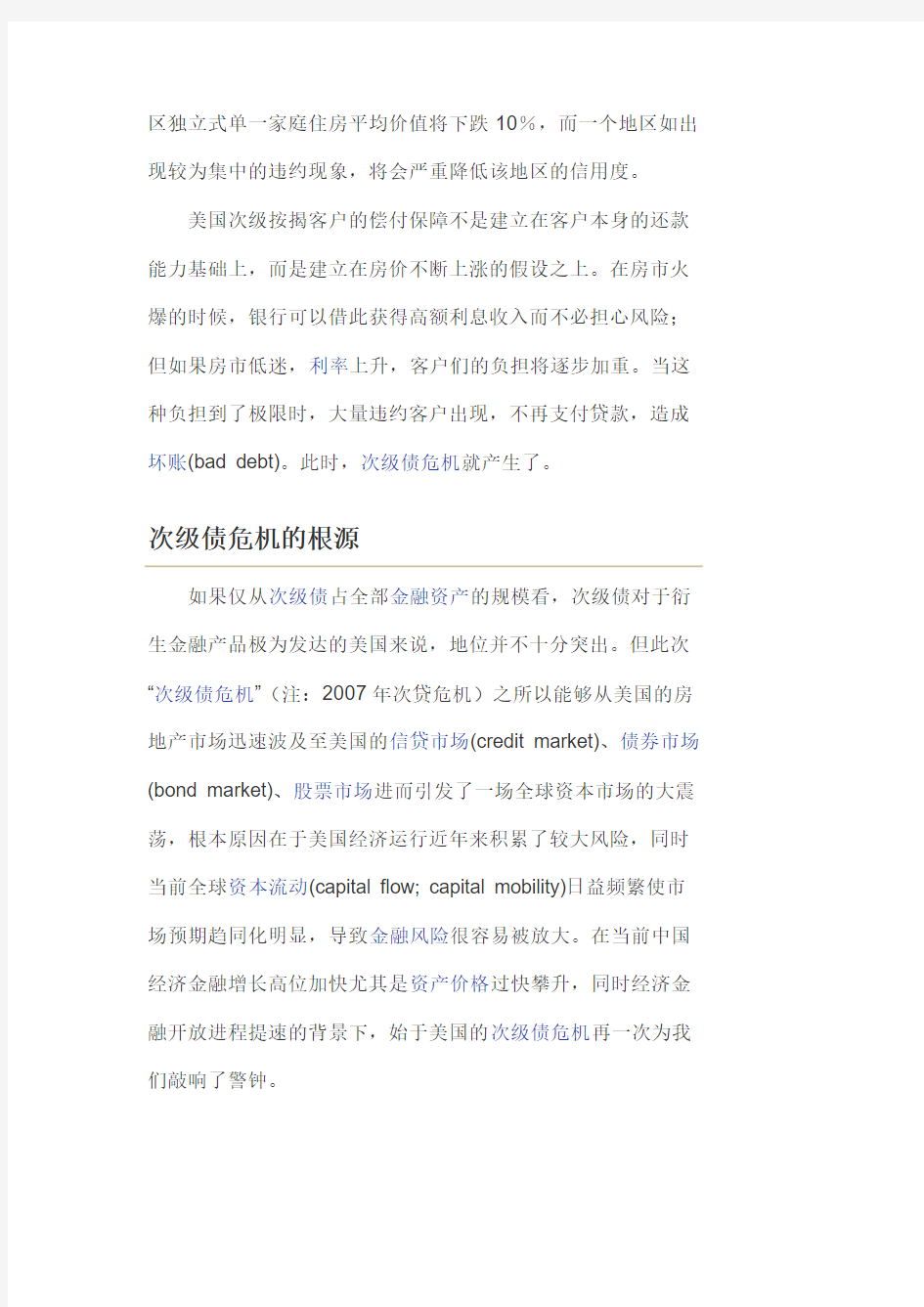什么是次级抵押贷款


什么是次级抵押贷款
美国抵押贷款市场的“次级”(Subprime)及“优惠级”(Prime)是以借款人的信用条件作为划分界限的。根据信用的高低,放贷机构对借款人区别对待,从而形成了两个层次的市场。信用低的人申请不到优惠贷款(concessional loan),只能在次级市场(secondary market)寻求贷款。两个层次的市场服务对象均为贷款购房者,但次级市场的贷款利率通常比优惠级抵押贷款高2%~3%。
次级抵押贷款(mortgage loan)具有良好的市场前景。由于它给那些受到歧视或者不符合抵押贷款市场标准的借款者提供按揭服务,所以在少数族裔高度集中和经济不发达的地区很受欢迎。
次级贷款对放贷机构来说是一项高回报业务,但由于次级贷款对借款人的信用要求较优惠级贷款低,借款者信用记录较差,因此次级房贷机构面临的风险也天然地更大:瑞银国际
(United Bank of Switzerland)(UBS)的研究数据表明,截至2006年底,美国次级抵押贷款市场的还款违约率高达10.5%,是优惠级贷款市场的7倍。
对借款者个人而言,违约会使其再融资难度加大,丧失抵押品的赎回权(foreclosure),无法享有房价上涨的利益。而且,任何一个借款人的违约对借款者所居住地区也有不良影响。据芝加哥的一项调研,一个街区如果出现一起违约止赎,则该街
区独立式单一家庭住房平均价值将下跌10%,而一个地区如出现较为集中的违约现象,将会严重降低该地区的信用度。
美国次级按揭客户的偿付保障不是建立在客户本身的还款能力基础上,而是建立在房价不断上涨的假设之上。在房市火爆的时候,银行可以借此获得高额利息收入而不必担心风险;但如果房市低迷,利率上升,客户们的负担将逐步加重。当这种负担到了极限时,大量违约客户出现,不再支付贷款,造成坏账(bad debt)。此时,次级债危机就产生了。
如果仅从次级债占全部金融资产的规模看,次级债对于衍生金融产品极为发达的美国来说,地位并不十分突出。但此次“次级债危机”(注:2007年次贷危机)之所以能够从美国的房地产市场迅速波及至美国的信贷市场(credit market)、债券市场(bond market)、股票市场进而引发了一场全球资本市场的大震荡,根本原因在于美国经济运行近年来积累了较大风险,同时当前全球资本流动(capital flow; capital mobility)日益频繁使市场预期趋同化明显,导致金融风险很容易被放大。在当前中国经济金融增长高位加快尤其是资产价格过快攀升,同时经济金融开放进程提速的背景下,始于美国的次级债危机再一次为我们敲响了警钟。
经济决定金融,次级债危机始于美国房地产市场。911事件后,在宽松货币政策(easy monetary policy)、积极减税政策的刺激下,美国的住房消费需求(consumer demand)迅速增长,而全球流动性过剩(Excess Liquidity)亦使得房贷市场供大于求,消费者和金融机构的风险偏好(risk preference; risk appetite)普遍增强,房屋抵押贷款快速增长,并推动了房价格迅猛上涨。但随着美联储货币政策的紧缩和油价不断上涨,美国经济复苏放缓和居民收入增速下降,消费者还贷压力不断加大,违约风险开始集中暴露,房价也开始下跌。
这种风险迅速传至美国的信贷市场。近年来美国旺盛的信贷需求使金融机构的整体风险意识普遍有所淡化,为提高收益而忽视操作风险的倾向在业务扩张中亦不断强化。违约事件(default)集中暴露后,许多金融机构陷入了不良资产
(non-performing asset)激增、抵押品赎回权丧失率上升和资金周转紧张的困境,加之对美国经济增长预期放缓,一些金融机构提前催收可疑贷款(doubtful loan)的措施进一步增加了违约事件的发生。
信贷资产质量问题的暴露又很快传导至资本市场。首先,次级债危机直接导致以房屋抵押贷款为证券化标的的各类债券的贬值,一些优质债券也由于市场的普遍看淡而遭到错杀,同时一些与次级债类似的企业债亦被投资者抛售。其次,投资于次级债和其他高风险债券的基金遭到抛售(bear sale)和赎回
(redemption),与房地产相关行业的股票也受到重创,加之不良的市场预期引导,美国股指近来下跌明显。
在目前全球资本流动日益频繁且国际企业多地上市的背景下,出于对受次级债牵连企业的盈利前景及经济增长前景的担忧,全球股市普遍出现了一种不良预期,最终引发了一场令人关注的股市大动荡。
可见,次级债危机的根源在于美国的房地产市场泡沫的堆积以及居民的过度负债消费。房价下跌后,大量的房屋抵押消费贷款来源被切断,导致作为美国经济增长主要推动力的消费增长乏力,经济增长预期进一步下降,如此形成恶性循环。The Cause of the 2008 Financial Crisis
James F. Davis —October 14, 2008
20 Comments | Printer Friendly
As someone who spent the majority of his life as an international bank analyst and executive, I learned, that to fix a problem, one needs to understand what caused it. It can be difficult to see because sometimes it takes time for the effects of bad decisions to manifest themselves. It also requires that we examine the facts rather than our emotional biases.
The facts are that approximately 6% of all mortgage loans
in United States are in default. Historically, defaults were less than one-third of that, i.e., from 0.25% to 2%.
A huge portion of the increased mortgage loan defaults are what are referred to as …sub-prime? loans. Most of the
sub-prime loans have been made to borrowers with poor credit ratings, no down payment on the home financed, and/or no verification of income or assets (Alt-A?s). Close to 25% of sub-prime and Alt-A?s loans are in default.
These loans increased dramatically as a 9/30/99 New York Times article explained, “In a move that could help increase homeownership rates among minorities and low income consumers, the Fannie Mae Corp. is easing the credit requirements on loans that it will purchase from banks and other lenders.”
Why would banks make such risky loans? The answer is that the Clinton administration pressured the banks to help poor people become homeowners, a noble liberal
idea. Also the Clinton Justice Department threatened banks with lawsuits and fines ($10,000 per application) for redlining (discrimination) if they did not make these loans. Also ACORN (Obama?s community service organization) was instrumental in providing borrowers and pressuring the banks to make these loans.
To allow Fannie Mae to make more loans, President Clinton also reduced Fannie Mae?s reserve requirement to 2.5%. That means it could purchase and/or guarantee $97.50 in mortgages for every $2.50 it had in equity to cover possible bad debts. If more than 2.5% of the loans go bad, the taxpayers (us) have to pay for them. That is what this bailout is all about. It is not the government paying the banks for the bad loans, it is us!!
Principally Senate Democrats demanded that Fannie Mae & Freddie Mac (FM&FM) buy more of these risky loans to help the poor. Since the mortgages purchased and guaranteed by FM&FM are backed by the U.S. government, the loans were re-sold primarily to investment banks which in turn bundled most of them, taking a hefty fee, and sold the mortgages to investors all over the world as virtually risk free.
As long as the Federal Reserve (another government created agency) kept interest rates artificially low, monthly mortgage payments were low and housing prices went up. Many home owners got home equity loans to pay their first mortgages and credit card debt.
Unfortunately home prices peaked in the winter of 2005-06 and the house of cards started to crumble. People could no longer increase their mortgage debt to pay previous debts. Now, we taxpayers are being told we have to bail out the banks and everyone in the world who bought these highly risky loans. The politicians in Congress (mostly Democrats) do not want you to know they caused the mess.
During the past eight years, the Bush administration made 17 attempts to reform FM&FM, having been made aware by whistleblowers that the books had been cooked by Clinton appointees, James Johnson and Franklin Raines (most recently Barack Obama financial advisors) who gave large bonuses to themselves and other Clinton appointees by falsely showing huge profits.
In 2005, John McCain submitted a Fannie Mae reform bill. Democrats blocked it in Committee from getting to the Senate floor for a vote.
By 2006 there was enough evidence of malfeasance that Raines was forced out. He had paid himself over $90 million. Recently the court ordered him to pay back $40 million in fines, bonuses and stock options that he gave himself based on false financial statements of Fannie Mae profits.
In the 2006 elections, the Democrats took control of the House and Senate. There are plenty of videos on the Internet showing many Democrats including Senate Banking Committee Chairman Democrat Christopher Dodd and House Banking Committee Chairman Barney Frank, responsible with overseeing FM&FM, assuring us that there were no problems with FM&FM right up to their collapse.
Not surprisingly, virtually all the investment banks that are in trouble and being bailed out are run by financial supporters of Obama and other Democrats. Secretary of the Treasury Paulsen was head of Goldman Sachs. The new head of the $700 million bailout is also from Goldman Sachs. This is like letting the fox be in charge of hen house security.
It was announced that our government will infuse capital into the troubled banks. This gives whoever is in power of our government the ability to force the same kind of abuses that have caused this massive banking crisis in the first place.
Barack Obama has received more campaign donations that any other politician in the past three years from Fannie Mae and Wall Street. FM&FC have been virtually private piggy banks of campaign contributions for Democrats for
the past 10 years. Yes, a token amount went to some Republicans.
And there is plenty of blame to go around in this financial crisis, but the reason it happened was 100% caused by a Democrat run government that forced a liberal policy initiated by President Clinton and reforms primarily blocked by Democrats. One would never know this by watching the news or reading newspapers.
Until the majority of our citizens understand whom (government liberals) and what (liberalism/socialism) caused this mess, we will allow our elected officials, through massive inflation, to lower the standard of living of those of us who are financially prudent and give our earnings to those who are not prudent.
The big excuse for the bailout is that credit markets have frozen up. But it is not true. There is plenty of credit available for good credit risks.
The only way this can be rectified is to allow the people who made the mistakes to take their losses. It is called taking personal responsibility for one?s actions.
Already we see that the bailout has had virtually no effect on the markets other than to cause huge sell offs because smart investors see that the U.S. is adopting failed liberal socialist policies. Our government is following in the footsteps of Hoover and Roosevelt.
We do not need to have another depression, but the government is taking the steps to make it happen. The taxpayer financed bailout should be reversed immediately
as it will only encourage more irresponsible fraudulent behavior.
北岩银行Northern Rock
资产证券化asset securitization
按揭证券化mortgage securitization
房利美Federal National Mortgage Association; Fannie Mae
房地美Freddie Mac
雷曼兄弟Lehman Brothers
骨牌效应domino effect
金融衍生品financial derivative
美林证券Merrill Lynch
摩根士丹利Morgan Stanley
高盛证券Goldman Sachs
